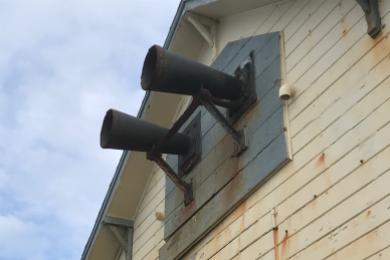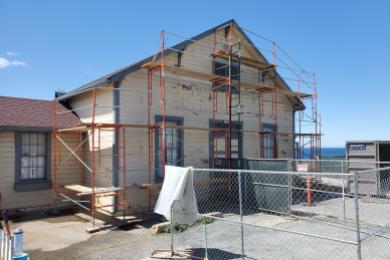Sitting on the very edge of the ocean bluff, the fog signal building has experienced the brutal effects of the marine environment. Siding planks were separating from the wall, especially on the south side where the storms do their worst damage. The soffits, eaves and building trim were also pulling away from the structure, leaving large gaps for storm water, birds and other invaders to enter. The windows were unusable and some of the glass panes were falling out. The fog horns on the back of the building were rusted and pieces had broken away.
Since the fog signal building serves as Pigeon Point’s Interpretive Center, there was a great deal of concern about protecting the building’s contents. Opened in 2007, the center offers a step back into history with artifacts, exhibits and Pigeon Point’s iconic first order Fresnel lens on display.
Work began with lead abatement around the entire building. The siding, especially on the south side, was re-fitted or replaced to close the building’s envelope to the elements. Soffits, eaves and trim were repaired or replaced. The windows were all removed for rebuilding and the openings covered in plywood. The muntins (those grids that hold the panes in place – yes, I had to look it up!) were all replaced and as much of the original glass as possible was preserved. Everything was then primed and painted, including the fog horns.
One additional task was the removal of the deck promontory. Though extremely popular with visitors, its underpinnings had become unstable. It was deemed unsafe for workmen to rebuild it and was removed.
The three-month project was jointly funded by Coastside State Parks Association and Friends of Santa Cruz State Parks. With the scaffolds and fencing removed, a virtual ribbon cutting was held with representatives of both organizations and California State Parks.


